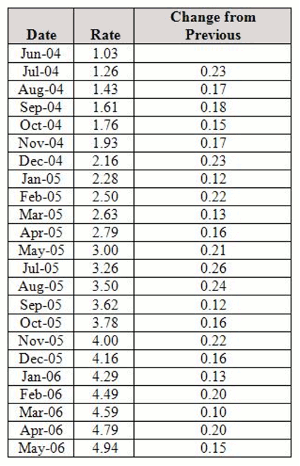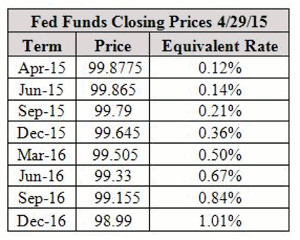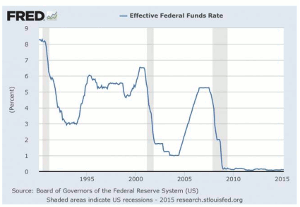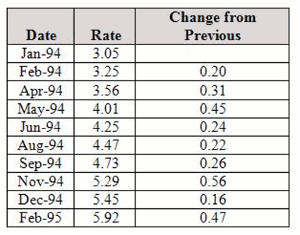Matthew Krupski of Archer Financial Services discusses last week’s less-than-surprising FOMC announcement and takes a historical look at how the Fed has raised rates in the past to illustrate that—if rate hikes are quicker than the market expects this time—a way to take advantage is by buying near term Fed Funds futures and selling further out Fed Funds futures.
The latest Federal Open Market Committee meeting came and went last week, with few surprises in the statement they released. The FOMC has had a near-zero interest rate target policy in place for over half a decade now, although many analysts are expecting this to change soon. If we dissect what they say in their statement, and compare that with what some analysts believe and what the market reflects, we find some interesting things.
Some observers believe that the Federal Reserve will raise their target funds rate simply to begin to normalize rates. Historically, US short-term interest rates have never been this low for this long and people in some circles believe that the Federal Reserve will start to slowly raise their target rate simply to bring it closer to the mean. There is some sound reasoning behind this view. The US economy is slowly improving and has been for some time. A slow rise in rates should not have a large effect on US businesses, but would bring economic conditions back to a more normalized state. In fact, the difference between 0% and 0.25%, or even 0.50% rates is minimal. Historically, those are still very low rates and theoretically business and the economy shouldn't be materially harmed by such a move. Additionally, a slow, small move in rates would give the Federal Reserve some flexibility to lower rates again should the economy slow at some time in the future.
This slow, steady rise in rates is currently reflected in Federal Funds Futures. In looking at the current prices of Federal Fund Futures across the term structure, we can extrapolate what the market expects the Fed to do over the next 12-18 months:
As of Wednesday, the FOMC's official target rate for the federal funds rate is 0-0.25%. The futures market confirms this view through September, with rates slowly creeping up toward the upper end of that range. From September through the following five quarters, the market is pricing in a rise of 80 basis points. This seems to conform to the slow and steady theory.
However, when one dissects the actual statement, the committee seems to be clear on one thing; it is strictly adhering to the dual mandate. The Federal Reserve is solely concerned with maximizing employment and stabilizing prices. The committee explicitly states that it will not raise rates until "it has seen further improvement in the labor market and is reasonably confident that inflation will move back to its 2% objective over the medium-term." The final sentence of the statement addresses the idea that they could normalize rates for normalization sake: "The Committee currently anticipates that, even after employment and inflation are near mandate-consistent levels, economic conditions may, for some time, warrant keeping the target federal funds rate below levels the Committee views as normal in the longer run." In other words, they are not going to normalize rates just to normalize rates and may even keep target rates lower than the market expects should the data allow it. The FOMC has every incentive to be transparent and I would take them at their word that they will only be raising rates when the economic data and forecasts require it.
NEXT PAGE: How Quickly Has the Fed Raised Rates in the Past?
|pagebreak|If we take them at their word and believe that they will only raise rates once inflation and an improving job market forecast forces them to, how should futures markets be pricing in rate hikes? For this answer, I think we should look at what the Fed has done historically. We can see from the graph below that in the last 25 years, when the Fed has started to raise rates after sustained periods of relatively low rates, they have most often done so quickly.
In 1994-1995, the Fed went from 3% rates to 6% in a period of 13 months, with several quick rate changes.
In 2004-2006, rates went from 1% to 5% over a period of 24 months, with rates rising at least 1/8th or 1/4% consecutively practically every month.

All chart data from Federal Reserve Web site
Click to Enlarge
Historically, the Federal Reserve has followed its dual mandate and raised rates only when economic conditions forced them to. In the past, once they began the process of raising rates from a stable, relatively low value, they have continued to do so at a steady clip. I have little reason to believe that this time will be different. The Fed may very well wait longer than the market expects to raise rates, but once they begin, the pace of rate hikes may be quicker than the market is currently anticipating. While the FOMC has never had to raise rates from such a low value—and consecutive quarter point rate hikes would be a much larger move on a percentage basis than in previous times—they have demonstrated that they will wait to raise rates until they know the market can safely accommodate higher rates—and once they start—they often continue to hike quickly.
If you believe that rate hikes will be quicker than the market expects, you could take advantage of this situation by buying near term Fed Funds futures and selling further out Fed Funds futures. The difference between June 2016 Fed Funds futures and December 2016 Fed Funds futures is currently 34 basis points. Should the Fed begin hiking rates by December of 2015, and follows through with consecutive hikes, I would expect this spread to widen dramatically. If the market prices in 1/8th point hikes monthly, as the Fed has done before, this six month spread should widen out to 75 basis points. It should be noted that while the Fed only sets a rate target, and doesn't set actual rates, the target rate, the rates realized in the markets, and the futures markets are all highly correlated.
Of course, one should remember that futures trading is a risky endeavor and not suitable for all investors.
Futures and options trading involve significant risk of loss and may not be suitable for everyone. Therefore, carefully consider whether such trading is suitable for you in light of your financial condition. The risk of loss in trading futures and options can be substantial. The views and opinions expressed in this letter are those of the author and do not reflect the views of ADM Investor Services, Inc. or its staff. Research analyst does not currently maintain positions in the commodities specified within this report. The information provided is designed to assist in your analysis and evaluation of the futures and options markets. However, any decisions you may make to buy, sell or hold a futures or options position on such research are entirely your own and not in any way deemed to be endorsed by or attributed to ADMIS. Copyright© ADM Investor Services, Inc.
By Matthew Krupski of Archer Financial Services























